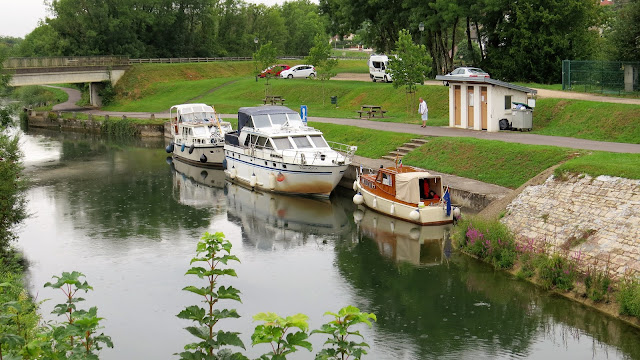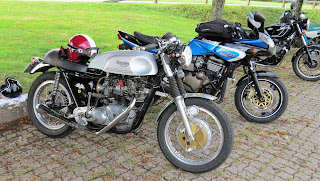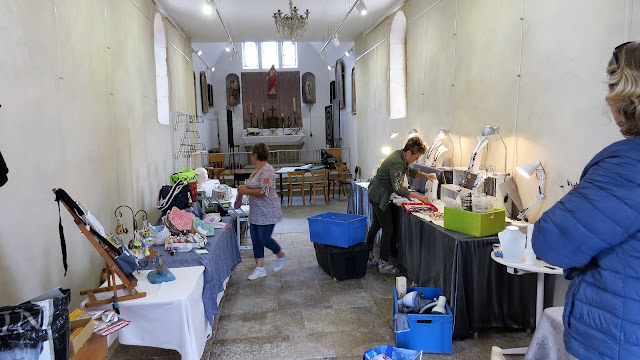7 August to 13 August 2019. 44 kilometers, 15 locks.
Wednesday 7 August.
Saint-Jean-de-Losne to Abergement le-Ronce. 10,5 kilometers, 3 locks. 3 hours, 45 minutes (See
delays below).
Waking to a very grey day with heavy rain forecast after the big storm
of the night before, we pushed off before nine, turned downstream to the
quayside fuel bowser and then, just on cue, the heavens opened! We managed to
get in one hundred and fifty liters of diesel (and hopefully no water) before
setting off again upstream to our first lock, upon arrival at which, there were
two boats waiting for service. So we tied up, Lynn scrubbed the one side of the
hull and, after a good thirty minutes, the lock emptied, I executed a very
clumsy turn and scraped Lynn’s newly painted handrail, up we went, collected
our telecommand and we were finally on our way to Dole.
 |
| Madame scrubbing the hull in fine weather. |
Or so we thought.
A short way before the second lock we spot a very small boat (maybe six
meters long), with two people aboard, tied to the side, and see their engine
splutter into life. The man does a little jig and I think that they had just
resolved an engine issue but they have more devious plans. As we pass, they up-pins and follow us to the lock, forcing us to the front to fight the
deluge. He then asks that we move even further forward because they need to get
to the ladder to climb up and get their lines around a bollard; I asked him why
he had waited for us to pass and then follow us into the lock rather than just
going into the lock before we arrived on the scene. His reply: “Why don’t you
just help with our lines – you only have a couple of steps to climb up the (very
slimy) ladder and we have a lot” - and then the penny dropped. They were waiting for a single,
‘big’ boat to come along who would do their dirty ladder work for them and take
the force of the inrush, while they just sat back and relaxed on the way to
their next destination – probably Dole, another seventeen kilometers and
five locks ahead. Hence the jig when they spotted their prey. And they took
forever to sort themselves out in the lock. Even the maintenance lockie looked on in utter astonishment!
So five or so kilometers later we tied up at the empty quay at Abergement
le-Ronce which is just before lock number four and watched as they passed in the
pouring rain to do the lock-through on their own. And it’s a high one which we
hope they enjoyed – the boat’s name is Archibald Haddock, by the way!
And then there was nothing much to do but sit out the torrential
rainstorm which lasted, with intermittent sunny breaks, well into the evening.
 |
| One hour later! |
 |
| More storm clouds building. |
Thursday 8 August. Abergement
le-Ronce to Rochefort-sur-Nenon. 19,5
kilometers, 8 locks. 4 hours, 30 minutes.
Early the next morning, a quick walk through the nondescript and deserted
town (except for the neon flashing boulangerie)
 |
| The view from Elle's foredeck the next morning. |
 |
| The main road looking left... |
 |
| ...and looking right. |
ended with us heading off into
the lingering fog, passing the almost ghostly chemical factory
until just
before Choisey when the sun came out, showing off a sparkling day. We had a
short delay at the first lock after Dole but thankfully no other boats came up
behind us and we glided into the lock all on our ownsomes. Rising, a glance
over the lock doors revealed Archibald Haddock waddling toward the lock
and, with hopefully only one more lock to go before our intended and earnestly
hoped-for stopover at Rochefort-sur-Nenon (described in a cruising guide as “Peaceful,
picturesque river mooring. Pontoon in high demand”), we knew that they would never
catch us but, after the previous day, probably didn’t want to anyway.
The seven kilometers after Dole has some very pretty cruising and just
after passing through the narrow check-lock one passes onto the wide Doubs river,
bordered on one side by high sandstone or limestone cliffs topped by the Forest of Chaux, at
the base of which is the twenty-five-meter long pontoon – with only one small
Med-type speedboat parked there. Another bonus of this particular stopover is
that the cliffs give protection from the hot, late afternoon sun.
 |
| Toilets (well frequented by the dozens of passing cyclists), a washing up basin with water, rubbish bins and a bottle recycling container. |
 |
| View forward off our bow. |
 |
| And astern. |
The riverbank seems a favourite place for couples and families to
picnic under the trees, fish in the river and relax in the most decorous way –
no loud music, no drunkenness, and no mess after they all went home. Bliss!
So
much so that we will extend our stay here, even if it means running engines for
an hour or two to keep the batteries topped up so that the fridges can cope in
the high temperatures expected. And the village is having a ‘fête’ all weekend
with petanque competitions, bands, and dancing - and a vide grenier.
The village itself is mostly quaint but seemingly devoid of any
commerce except for a Tabac.
 |
| The Tabac. |
 |
| The 18thC Eglise Saint-Laurent - the first church in the area dated from AD1000. |
 |
| Anyone for a fixer-upper? |
 |
| Part of the fortifications which eventually included the town into the hilltop fortress' defences. |
The village's history goes back to prehistoric times where evidence that Cro
Magnons inhabited the area. Later it was occupied by the Romans and a town named
Hebe was established on the salt road to Auxonne – it was at this time that a
castillum was built on the Rochefort cliffs to protect the road. After the fall
of the Roman Empire, the hilltop castle and town below fell under the control of
the Dukes of Burgundy and the castle and town were named Rochefort after one of
the powerful Burgundian nobles who, during a period of power-struggle amongst
the ruling Dukes, did a land grab and refused to pay homage but eventually, and
after a few wars, the land reverts to France.
“On
May 23, 1479, two days before the sack and the taking of Dole by Louis XI, the
Emperor Maximilian sells for 10,000 francs, Claude de Vaudrey "the city,
castle, town, and seigneury of Rochefort..." Less than a century
later, Philip II King of Spain and grandson Maximilian, bought Rochefort for
the same sum to the descendants of Claude de Vaudrey.
For
two centuries (from 1477 to 1678), Rochefort is almost autonomous under the
control of the Parliament of Dole appointed by the Emperor of Austria.
This
relative autonomy does not mean peace because the Franks Comtois see their
country ravaged successively by the Spanish troops, the Protestant
"reiters", the army of Henry IV, the War of Ten Years, the Swedes and
the rampage and looting by Louis XIV.” (Source: Rochefort-sur-Nenon Tourism ).
How’s that for a complex history!
It is only in 1678, in terms of the treaty of Nijmegen, that Rochefort,
along with Franche Compté, finally becomes French territory. And for the history buffs, follow this link to the Wiki font of all Dukes of Burgundy and the Kingdom of Burgundy knowledge - molecular physics is less complex!
The Friday night pétanque doubles competition and modern dance
exhibition we gave a miss as the weather turned and it poured with fat gobbets
of rain the whole night.
The next morning dawned cool and sodden but soon dried
out to a lovely day, thankfully even a bit windy. With long overdue maintenance
done
 |
| Painting again Bobette? |
we enjoyed a light lunch and then sauntered into the village
 |
| Creative! |
 |
| A portion of the visitors to the fete. |
to have a
look at what was on offer; a small exhibition of
motor-cycles,
‘pétanquers’ by the dozen, at least fifty triples
teams giving it their best,
and, in one corner of the community sports center,
a marquee had been set up for the music evening – “"Punchy Slug's"
(rock) et "And Co" (variétés françaises)” – fireworks display and an
Eighties Evening to end the day.
 |
| Punchy Slugs setting up. |
We sauntered back by way of the ramparts which have lovely views over
the valley.
 |
| The stop-lock. |
 |
| We are moored behind the big trees on the left. |
Sunday 11 August. Rochefort-sur-Nenon
to Ranchot. 14 kilometers, 4 locks. 3 hours, 35 minutes.
Before seven the next morning
 |
| Sunrise - a great shot taken by Lynn. |
WE (yes, both of us!) took a stroll into the village where a ‘vide
grenier’ had been set up and, after having wandered past the forty-or-so tables
and bought nothing (two in a row – a miracle!)
it was back to Elle
 |
| Another lovely one. |
and
we were on our way well before eight o’clock.
Our second lock gave some issues but Lynn hit the ‘reset’ button and
all came back to life, allowing us a gentle cruise through the next two locks
to find, on arrival at Ranchot, a space just big enough for us to fit into between
two other cruisers, waiting. By nightfall, a tiny German cruiser had squeezed into the
space in front of the boat on our bow, the sloping wall mooring on the opposite
bank had three boats attached and, on our side of the canal but beyond the
bridge downstream, a small Swiss cruiser had attached itself to the cycle path railings.
 |
| After the storm and before the next lot of rain. |
 |
| The next morning after the madding crowd had departed. |
Earlier in the afternoon, the skies blackened, thunder rolled and the rain came pelting down. During this deluge, we heard a knock on our window and,
on opening the curtain, there stood a very wet Swiss gentleman with an
electricity cord in his hand who asked, in what sounded like Flemish (I could
understand him but he could not understand my Afrikaans), if we could move our
connection to the outlet on our bow (which we knew was not working) as their
cable was ten meters too short to reach their boat. Not understanding what I
was saying, he summoned his friend who spoke English and, when we offered to
resolve the problem with a splitter, there were broad grins all round – and we
ended up being presented with a bottle of lovely Swiss Chianti!
The weather cleared somewhat the next morning so, armed with brollies,
we took a stroll through the surprisingly cute village, the only downside being
that the boulangerie is closed on Mondays.
 |
| The hotel fifty meters from the mooring. |
 |
| Looks nondescript but there are some little surprises. |
 |
| A gorgeous 'gite'. |
 |
| An old train tunnel built solely to service the iron mine. When the mining company moved its business to a barge company, the railroad company removed the tracks so that no-one could use the system. |
 |
| Founded in the 15thC, it has been deconsecrated and is now a small exhibition hall. |
 |
| Lunchtime at the smaller boat quay. |
On the last day of our extended stay in Ranchot, we off-loaded the bicycles
and rode the three kilometers into neighbouring Fraisans (the forge town), past
a huge field which had been host to the NoLogo music festival, to a Colruyt
supermarket to stock up and, after dropping said provisions off at the boat,
rode across the bridge to Rans (can someone tell us how that is pronounced
differently to Reims?), another quiet but pretty litte vilage
 |
| We think an old pottery factory. |
 |
| The Church of St Etienne, dating from the 14thC |
 |
| Once a mansion, then a school, now apartments. |
 |
| The elusive Chateau de Rans dating from the 12thC. Now a private home. |
 |
| I just could not find a decent view from which to photograph it. |
 |
| A Brexit statement? |
 |
| Foraging rewards. |
Back to Ranchot and our plans for a braai were swept aside by the news
that the nearby hotel was serving ‘pied de veau’ (veal foot/trotter/knuckle) as
part of their plat de jour – and a most enjoyable and inexpensive meal it was
too!
Did I mention that our house water pump is dying? The diaphragm seems
to have collapsed so a new one will have to be installed in Deluz.
 |
| The little blue pig. |
We have thoroughly enjoyed ‘slowing down’ in Ranchot but it’s time to
get moving again.

















































Doormat :D:D:D
ReplyDelete